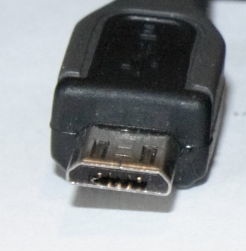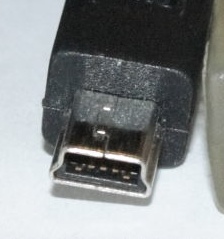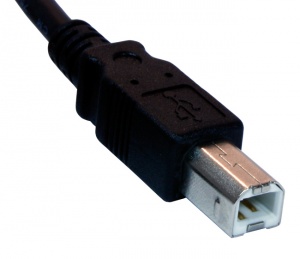Difference between revisions of "Galileo"
| Line 1: | Line 1: | ||
The Galileo is a fusion of a Linux PC running Intel's architecture and an Arduino. The purpose is to provide the benefits of a pc (connectivity, power, storage, ports) with the benefits of an Arduino (an open-platform hardware interface.) | The Galileo is a fusion of a Linux PC running Intel's architecture and an Arduino. The purpose is to provide the benefits of a pc (connectivity, power, storage, ports) with the benefits of an Arduino (an open-platform hardware interface.) | ||
| − | This page is intended to express what we've learned about the Galileo. There are other resources, and | + | This page is intended to express what we've learned about the Galileo. There are other resources, and Google is your friend, but this is the knowledge we've learned from our experience here. |
=Getting Started Guide= | =Getting Started Guide= | ||
==Galileo== | ==Galileo== | ||
To start with, you need three things to use the Galileo board and to run Arduino sketches: | To start with, you need three things to use the Galileo board and to run Arduino sketches: | ||
| − | # | + | # Galileo Board |
| − | # | + | # USB cable to connect board to computer |
| − | # The Galileo development software ( | + | # The Galileo development software (special version for Galileo that you can get [https://communities.intel.com/docs/DOC-22226 here]) |
| − | |||
| − | |||
Follow this tutorial, | Follow this tutorial, | ||
| Line 18: | Line 16: | ||
* Complete steps 7, 8, 9, and 10. They shouldn't take long. | * Complete steps 7, 8, 9, and 10. They shouldn't take long. | ||
| − | In addition, this | + | In addition, this [https://learn.sparkfun.com/tutorials/galileo-getting-started-guide/all Sparkfun guide] might be useful. |
==Arduino== | ==Arduino== | ||
| − | |||
| − | |||
=Resources & Reference= | =Resources & Reference= | ||
| Line 43: | Line 39: | ||
==Design Philosophy== | ==Design Philosophy== | ||
* When doing research talk to scientists early on. Seriously, it helps. | * When doing research talk to scientists early on. Seriously, it helps. | ||
| − | * Test after every change. | + | * Test after every change. This saves a lot of time. |
* When success has been reached, do it again. Document it. | * When success has been reached, do it again. Document it. | ||
* When success has been repeated, have others do it. Spread your success. | * When success has been repeated, have others do it. Spread your success. | ||
| Line 49: | Line 45: | ||
==Troubleshooting Checklist== | ==Troubleshooting Checklist== | ||
# The Galileo is still a beta product and can be finicky. Google is your friend. | # The Galileo is still a beta product and can be finicky. Google is your friend. | ||
| − | # Be aware that some libraries/shields made for | + | # Be aware that some libraries/shields made for Arduino are not compatible with the Galileo at this time. |
** Known Issues: | ** Known Issues: | ||
*** The SotwareSerial library does not work. | *** The SotwareSerial library does not work. | ||
| Line 99: | Line 95: | ||
=Resources= | =Resources= | ||
| − | + | * [https://communities.intel.com/docs/DOC-22204 Installation Guide (super useful Galileo start guide)] | |
| − | + | * [http://arduino.cc/en/ArduinoCertified/IntelGalileo Technical Overview of Galileo (meet Galileo hardware] | |
| − | + | * [http://arduino.cc/en/Reference/HomePage Arduino Reference (meet Arduino software)] | |
| − | + | * [http://playground.arduino.cc/ Arduino Playground (meet Arduino software some more)] | |
| − | + | * [https://communities.intel.com/docs/DOC-21837 Release Notes (inc. supported software/hardware, bugs)] | |
| − | * | + | * [https://communities.intel.com/community/makers Intel Maker forums (inc. forum for Galileo)] |
| − | + | * [http://arduino.cc/en/Guide/HomePage Arduino Getting Started | |
| − | |||
| − | |||
| − | * | ||
| − | |||
| − | |||
| − | |||
| − | * | ||
| − | |||
| − | |||
| − | |||
| − | |||
| − | |||
| − | |||
| − | |||
| − | |||
| − | |||
| − | |||
| − | |||
| − | |||
=Downloads= | =Downloads= | ||
| − | + | * [https://downloadcenter.intel.com/Detail_Desc.aspx?DwnldID=23171 Software Packages] | |
| − | + | * [https://communities.intel.com/docs/DOC-22226 Drivers] | |
| − | |||
| − | |||
=Research= | =Research= | ||
Moved to [[Disaster-Preparedness|here]]. | Moved to [[Disaster-Preparedness|here]]. | ||
| − | |||
=Code= | =Code= | ||
Revision as of 16:33, 15 May 2015
The Galileo is a fusion of a Linux PC running Intel's architecture and an Arduino. The purpose is to provide the benefits of a pc (connectivity, power, storage, ports) with the benefits of an Arduino (an open-platform hardware interface.)
This page is intended to express what we've learned about the Galileo. There are other resources, and Google is your friend, but this is the knowledge we've learned from our experience here.
Contents
Getting Started Guide
Galileo
To start with, you need three things to use the Galileo board and to run Arduino sketches:
- Galileo Board
- USB cable to connect board to computer
- The Galileo development software (special version for Galileo that you can get here)
Follow this tutorial,
- Getting started guide from Intel
- Start with step 3. Complete it.
- Complete step 4 and 5.
- Complete steps 7, 8, 9, and 10. They shouldn't take long.
In addition, this Sparkfun guide might be useful.
Arduino
Resources & Reference
Basic Electrical Reference:
The Galileo requires 5 volts of incoming power. Do not use more; I killed one this way. The Galileo will output 3.3volts or 5 volts on its digital output pins which is compatible with Arduino devices.
Please give these at least a glance so you don't end up frying your sensors!
Photos
Design Philosophy
- When doing research talk to scientists early on. Seriously, it helps.
- Test after every change. This saves a lot of time.
- When success has been reached, do it again. Document it.
- When success has been repeated, have others do it. Spread your success.
Troubleshooting Checklist
- The Galileo is still a beta product and can be finicky. Google is your friend.
- Be aware that some libraries/shields made for Arduino are not compatible with the Galileo at this time.
- Known Issues:
- The SotwareSerial library does not work.
- The Stepper motor library (and the Motor Shield) don't work.
- More broadly, any routine that relies on fast toggling of the digital or analog pins will not work the same on Galileo because of hardware limitations.
- Known Issues:
- Troubleshoot the best you can.
- If nothing else works,
- try a different piece of hardware.
- try unplugging/replugging or restarting or the equivalent.
- If you're still having trouble, ask a TA.
Connection Issues
- Are both of the LEDs on the Galileo not lighting up?
- Is the power plugged in?
- Maybe power is routed incorrectly on the breadboard. Try unplugging the power pins on the Galileo and seeing if it works.
- If working in the Arduino IDE,
- are you using Galileo's Arduino IDE?
- are you using the correct port?
- are you using the correct board?
- do you have the mini usb cable plugged in next to the Ethernet port?
- unplug/replug the USB and wait 30-60 seconds
- unplug/replug the USB and power and wait 30-60 seconds (power always gets unplugged last)
- If on Windows, and without hope, try changing the COM port of the Galileo and restarting your computer.
- If working in the Galileo terminal,
- do you have the RS232 -> 3.5mm cable plugged in next to the Ethernet port?
- are you using the correct port?
- are you using the correct username / password?
Breadboard/Sensor Issues
- software,
- Is the pin mode set correctly?
- Are you using the correct pin numbers? Analog or digital?
- hardware,
- are your wires loose?
- are you using the right resistor for that sensor?
- do you actually know which cables go where?
- power,
- are the power and ground connected correctly?
- If your power columns are separated into multiple sections, are you bridging power as needed?
- If too many sensors are connected you might run out of power. Try unplugging power from some sensors.
Resetting the Galileo
- Unplug the Galileo cables connected to your computer.
- Unplug Galileo's power.
- Replug power. Wait for the one light. (Which light?)
- Replug cables. Ensure that the device port is the same.
Resources
- Installation Guide (super useful Galileo start guide)
- Technical Overview of Galileo (meet Galileo hardware
- Arduino Reference (meet Arduino software)
- Arduino Playground (meet Arduino software some more)
- Release Notes (inc. supported software/hardware, bugs)
- Intel Maker forums (inc. forum for Galileo)
- [http://arduino.cc/en/Guide/HomePage Arduino Getting Started
Downloads
Research
Moved to here.
Code
Pins
You must specify which pin you're using to read/write to the Galileo. Declare variables for each of the pins you're using at the top of your code. It'll make life simpler.
For example use,
- const int pin_temp = A0;
- const int pin_tilt = 4;
to give your pin a useful name and to make the pin number easier to change.
Analog vs Digital
- analog pins,
- analog pin numbers have an "A" in front of them, like A0, A1, A2, etc
- return a range of values between 0-1023 when read from
- use values 0-255 when written to
- required for sensors that provide a range of values
- can be used as digital pins if necessary
- digital pins,
- digital pin numbers are referenced by number, like 0, 1, 2, etc
- return binary values, either 0 or 1
- can not be used as analog pins.
Setting PinMode
The pinmode ensures that you only read/write from a pin. It helps prevent bugs.
for input use,
- pinMode(pin, INPUT);
for output use,
- pinMode(pin, OUTPUT);
Read vs Write
- for analog,
- analogRead(pin)
- analogWrite(pin, value)
- for digital,
- digitalRead(pin)
- digitalWrite(pin, value)
Printing to the Serial Interface
- set serial baud rate in setup using,
- Serial.begin(9600);
- write to serial using,
- Serial.print(str);
- Serial.println(str);
Sleeping
- sleep like this,
- delay(length); where length is in ms
IoTKit
IoTKit allows you to publish data to intel's cloud Internet of Things service. It's an easy way to make your sensor's data remotely readable.
https://github.com/enableiot/iotkit-samples
Hardware Specs
- 400mhz cpu
- 256mb ram
- max of 32gb micro sd
- 10/100 ethernet
- PCI Express mini-card with up to PCIe 2.0
- USB host and client
- 5v/3.3v power
- same Arduino pin layout
Arduino Sensors
System Administration
restarting IoTkit
0) ssh as root: ssh root@galileo-<galileo#>
1) change directory to iotkit-agent-master: cd iotkit-agent-master
2) run the shell script start-agent.sh: ./start-agent.sh
3) if that fails run node agent: node agent
creating a non-root user
For the non-sys admin types use:
0) create the user eccs and a home directory for it.: useradd -m -d /home/eccs eccs
1)change the password using: passwd
Updating Node.js To update node.js on the Galileo
0) download this package
1) unzip the file and scp the file to the board
2) move the package to /tmp on the board
3) Run the command opkg install /tmp/nodejs_0.10.25-r0_i586.ipk
4) To confirm correct version run node -v
Building Custom Images
Setting up the BSP Build Environment
- You will need:
- Linux (Tested on Debian 7.5 and Debian 7.0, other distros may also work)
- Up to 30 gb disk space
- The latest version of the Board Support Package sources from Intel
- A copy of the Intel Quark BSP Build Guide, avaliable at the same location, for additional reference
- Host machine setup:
- Necessary Packages:
- build-essential
- gcc-multilib
- vim-common
- git
- diffstat
- texinfo
- gawk
- chrpath
- file
- Apart from installing those packages, no part of this process requires root access.
- Necessary Packages:
- Setting up the working directory (from section 6 of the BSP build guide)
- Extract the Board Support Package into a convenient working directory
- Run the following commands:
tar -xvf meta-clanton*.tar.gz
cd meta-clanton*
./setup.sh
- Patch one source file to account for a changed checksum
sed -i 's/1cffe9f406cc54f4759fc9eeb85598fb8cae66c7/bfed708c5358a2b4ef65923fb0683cefa9184e6f/' meta-oe/meta-oe/recipes-multimedia/x264/x264_git.bb
- Set up the build environment variables
source poky/oe-init-build-env yocto_build
- Build an image (This step will take several hours and require significant disk space and ram).
bitbake image-full-galileo
- The completed images will be found in ./tmp/deploy/images
- These files must be on the SD card for the Galileo to book correctly:
- grub.efi
- image-full-galileo-clanton.ext3
- core-image-minimal-initramfs-clanton.cpio.gz
- bzImage
- boot/
- These files must be on the SD card for the Galileo to book correctly:
Note that some of these files are symlinks; be careful to copy the file content.
Customize the Linux kernel of the image
- be in the root build directory (meta-clanton*/)
cd poky source oe-init-build-env
bitbake linux-yocto -c menuconfig
- enable the desired kernel components
- rebuild the kernel
from the meta-clanton* directory:
source poky/oe-init-build-env yocto_build
bitbake image-full-galileo
Customize the software added to the image
- Make sure that the package you wish to add has a recipe
List of layers and recipies each piece of software to be built for the Galileo has a recipie within a layer. Most layers containing applications are found within the meta-oe/ directory.
- Make sure the layer containing the recipie has been enabled in yocto_build/conf/bblayers.conf
if it hasn't add the path to the list of BBLAYERS
- run
bitbake <packageName>
be sure you are in the yocto_build directory and have sourced the oe-init-build-env script in that shell
- add the package to the image build script
edit the yocto_build/conf/local.conf file to include the line:
IMAGE_INSTALL_append = " <packageName>"
note that that leading space is vital (don't blame me, I didn't write this scripting system!)
- run
bitbake image-full-galileoto construct the new image.
Integrate support for FTDI USB-serial controllers
This is essential to the HERMES project. It also demonstrates how to customize the Galileo with .bbappend files.
- download the compendium of Galileo recipies from AlexT's github page
git clone https://github.com/alext-mkrs/meta-alext-galileo
- remove .disabled from the .bbappend file you wish to use
for us that's recipes-addfeatures/enable_ftdi_sio/linux-yocto-clanton_3.8.bbappend
- add the path to the layer directory to the yocto_build/conf/bblayers.conf file
- run
bitbake image-full-galileoagain.
IotKit Tutorial
Info Dump
IoTkit handles ethernet transactions. It connects to a host and sends a packet with [string, val] where val is the value you wish to send. You can save information locally and push it to a server later. A watch battery can be used to preserve machine state between power-on's. [validate]
There are no packages installed on Intel's Linux distro.
There's an interface for C++ that lets you access the Arduino.
Always connect the power first.
When flashing the firmware, YOU MUST HAVE THE POWER CONNECTED. Otherwise you risk bricking the board.
There are example sketches for every sensor included in Intel's sensor kit. Where? Good question.
Costs $60+ as of 2/5/14. Purchase is currently cheapest at [Micro Center] and [Amazon].


